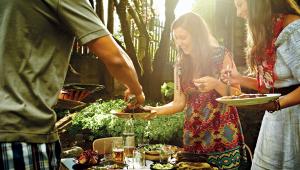5 green tips for your summer backyard bash
Submitted by Emily Boiteau on | Updated Sat, 17/09/2016 - 23:49

Summer has finally arrived, which means that the weather is finally allowing us to throw our much beloved backyard patio parties. Planning a get-together with friends and family involves preparing supplies, food, beverages, games and sometimes even decorations (if we are getting really fancy). Although it is tempting to take a more convenient route and head to a nearby dollar store to get paper plates and plastic cutlery, or going to a fast food restaurant for a quick and ready meal, those are not the most green options. Below are five easy steps to incorporate into planning your summer backyard bash that will help to make your gatherings a bit more eco-friendly.
1) BYO dishes, utensils, cups
Convenience of ten wins in the area of dishes and utensils when party planning. The simplicity of buying cheap plastic plates and cutlery and tossing them out at the end of the evening appears so ideal. However, there are consequences for using these types of materials rather than having your guest bring their own dishes, utensils and cups. Time for Change estimates that for each kilogram of plastic produced, 6kg of carbon dioxide are released into the environment.i Looking at plastic manufacturing in the United States, the EPA estimates that 3.3x1010 kg of plastic waste was generated in one year (2013) and only 9% of that waste was recovered for recycling.ii Plastic waste has detrimental effects on the environment, such as ending up in natural waterways (e.g.: The Great Lakes) and damaging components of local ecosystems. However, plastic recycling is becoming increasingly prevalent and more facilities have separate bins for varying plastic materials. Ultimately, putting an effort towards limiting your use of plastic materials would be the most beneficial to lowering emissions. Using your reusable household dishes and if you don’t have enough, ask your guests to bring their own dishes. Other eco-friendly alternatives exist for dishes and cutlery, such as those made from bamboo or compostable materials.
ten wins in the area of dishes and utensils when party planning. The simplicity of buying cheap plastic plates and cutlery and tossing them out at the end of the evening appears so ideal. However, there are consequences for using these types of materials rather than having your guest bring their own dishes, utensils and cups. Time for Change estimates that for each kilogram of plastic produced, 6kg of carbon dioxide are released into the environment.i Looking at plastic manufacturing in the United States, the EPA estimates that 3.3x1010 kg of plastic waste was generated in one year (2013) and only 9% of that waste was recovered for recycling.ii Plastic waste has detrimental effects on the environment, such as ending up in natural waterways (e.g.: The Great Lakes) and damaging components of local ecosystems. However, plastic recycling is becoming increasingly prevalent and more facilities have separate bins for varying plastic materials. Ultimately, putting an effort towards limiting your use of plastic materials would be the most beneficial to lowering emissions. Using your reusable household dishes and if you don’t have enough, ask your guests to bring their own dishes. Other eco-friendly alternatives exist for dishes and cutlery, such as those made from bamboo or compostable materials.
2) Send evites rather than paper invitations
 Evites are easily found online and are a FREE alternative to mailing out invitations for your summer parties. For those family members or friends who still remain offline, give them a call! Save some paper and also your precious party-planning time. According to a Green PDF presentation, the world average paper consumption per person is on average 56kg per year.iii Using the Environmental Paper Calculator, the production of 56kg of regular copy paper will emit 157kg of carbon dioxide.iv Of course the emissions will vary depending on type of paper product being produced. According to Environment Canada, paper and paper products account for 1/3 of all of Canada’s waste and only ¼ of that is recycled.v Make an effort to reduce emissions and the amount of waste produced by your summer bash and email the invitations.
Evites are easily found online and are a FREE alternative to mailing out invitations for your summer parties. For those family members or friends who still remain offline, give them a call! Save some paper and also your precious party-planning time. According to a Green PDF presentation, the world average paper consumption per person is on average 56kg per year.iii Using the Environmental Paper Calculator, the production of 56kg of regular copy paper will emit 157kg of carbon dioxide.iv Of course the emissions will vary depending on type of paper product being produced. According to Environment Canada, paper and paper products account for 1/3 of all of Canada’s waste and only ¼ of that is recycled.v Make an effort to reduce emissions and the amount of waste produced by your summer bash and email the invitations.
3) Use local or homegrown ingredients as much as possible
 We are encouraged to buy food from local markets for many reasons. Green Living outlined several great reasons such as contributing to our local economy and becoming empowered consumers and having better knowledge of who makes our food, what is (or is not) added to it and where it is produced.vi Another fantastic reason is the reduction of carbon emissions from the lower distance in which food is transported from production to our homes. As written in an article published on the World Watch Institute website, a study estimated that replacing imported food with items grown locally in the region surrounding Waterloo, Ontario would save 50 000 tonnes of CO2 (5.0x107 kgs).vii That amount of emissions is the roughly the same as taking 10 500 cars off the road.viii Hitting up your local market for fresh ingredients or using some of your homegrown vegetables and herbs is a satisfyingly delicious alternative for your summer party.
We are encouraged to buy food from local markets for many reasons. Green Living outlined several great reasons such as contributing to our local economy and becoming empowered consumers and having better knowledge of who makes our food, what is (or is not) added to it and where it is produced.vi Another fantastic reason is the reduction of carbon emissions from the lower distance in which food is transported from production to our homes. As written in an article published on the World Watch Institute website, a study estimated that replacing imported food with items grown locally in the region surrounding Waterloo, Ontario would save 50 000 tonnes of CO2 (5.0x107 kgs).vii That amount of emissions is the roughly the same as taking 10 500 cars off the road.viii Hitting up your local market for fresh ingredients or using some of your homegrown vegetables and herbs is a satisfyingly delicious alternative for your summer party.
4) Choose a central location for the party to promote sustainable modes of transportation
 According to information provided by the Smart Commute program by Metrolinx, for every litre of gasoline used by your vehicle 2.4kgs of carbon dioxide are produced.ix Using the Natural Resources Canada Fuel Consumption Ratings Search Tool, the average fuel consumption of midsized vehicles for city driving is around 9L per 100km.x If 10 of your guests are driving 20km to reach your party, that is around 18L of fuel consumption and 43.2kgs of carbon dioxide produced for the one way journey and 86.4kgs for returning back to their respective homes. By choosing a location closer to most of the guests’ homes, you are opening the possibilities of walking, cycling, transit and/or carpooling and therefore reducing the possibly 86.4kgs of carbon dioxide emissions. Go ahead, ask a friend if they are willing to host your bash at their place – it is in your best interest!
According to information provided by the Smart Commute program by Metrolinx, for every litre of gasoline used by your vehicle 2.4kgs of carbon dioxide are produced.ix Using the Natural Resources Canada Fuel Consumption Ratings Search Tool, the average fuel consumption of midsized vehicles for city driving is around 9L per 100km.x If 10 of your guests are driving 20km to reach your party, that is around 18L of fuel consumption and 43.2kgs of carbon dioxide produced for the one way journey and 86.4kgs for returning back to their respective homes. By choosing a location closer to most of the guests’ homes, you are opening the possibilities of walking, cycling, transit and/or carpooling and therefore reducing the possibly 86.4kgs of carbon dioxide emissions. Go ahead, ask a friend if they are willing to host your bash at their place – it is in your best interest!
5) Handing out seeds or tree seedlings as party favours
 Providing party favours for your guests, in my experience, is usually only for bigger events like a wedding reception. However, for those who want to offer some fun and eco-friendly favours, here a couple of options. At a family wedding that I attended last year, the couple provided a pretty clever party favour: they had paper infused with wildflower seeds that guests could easily plant in their gardens at home. What a useful gift! If you visit the Botanical Paperworks’ website, a company based in Winnipeg, they have a variety of options for seed paper party favours (including herbs!).xi A second option would be contacting a local nursery or garden centre for their options on tree seedlings. According to Natural Resources Canada, forests can act as carbon sinks by absorbing more carbon dioxide from the atmosphere than they release.xii Carbon sequestration is the process of carbon absorption and deposition by forests and is key to offsetting carbon emissions into the atmosphere. Tree Canada has a handy carbon calculator that can show you how many trees would need to be planted to offset your emissions.xiii Using the previous example of 10 people driving mid-sized vehicles 20km to your party, you would need to plant 2 trees to offset those carbon emissions. Regardless of emissions, providing tree seedlings as a party favour would greatly aid in the effort to off-set carbon dioxide emissions and would be a smart addition to your party planning.
Providing party favours for your guests, in my experience, is usually only for bigger events like a wedding reception. However, for those who want to offer some fun and eco-friendly favours, here a couple of options. At a family wedding that I attended last year, the couple provided a pretty clever party favour: they had paper infused with wildflower seeds that guests could easily plant in their gardens at home. What a useful gift! If you visit the Botanical Paperworks’ website, a company based in Winnipeg, they have a variety of options for seed paper party favours (including herbs!).xi A second option would be contacting a local nursery or garden centre for their options on tree seedlings. According to Natural Resources Canada, forests can act as carbon sinks by absorbing more carbon dioxide from the atmosphere than they release.xii Carbon sequestration is the process of carbon absorption and deposition by forests and is key to offsetting carbon emissions into the atmosphere. Tree Canada has a handy carbon calculator that can show you how many trees would need to be planted to offset your emissions.xiii Using the previous example of 10 people driving mid-sized vehicles 20km to your party, you would need to plant 2 trees to offset those carbon emissions. Regardless of emissions, providing tree seedlings as a party favour would greatly aid in the effort to off-set carbon dioxide emissions and would be a smart addition to your party planning.
i “Plastic bags and plastic bottles – CO2 emissions during their lifetime,” Time for Change, accessed June 25, 2015, http://timeforchange.org/plastic-bags-and-plastic-bottles-CO2-emissions.
ii
“Plastics,” United States Environmental Protection Agency, accessed June 25, 2015, http://www.epa.gov/osw/conserve/materials/plastics.htm.
iii
James DeRosa, “The Green PDF: Reducing Greenhouse Gas Emissions One Ream at a Time,” The Green PDF, May 3, 2007, accessed June 25, 2015, www.greenpdf.com/graphics/TheGreenPDFRevolution.pdf.
iv
“Paper Calculator”, Environmental Paper Network, accessed June 25, 2015, http://c.environmentalpaper.org/home
v
iD2 Communications, “Facts about Paper and Paper Waste”, iD2 Communications, accessed June 25, 2015, www.id2.ca/downloads/eco-design-paper-facts.pdf.
vi
“Benefits of buying local food”, GreenLiving, accessed June 25, 2015, http://www.greenlivingonline.com/article/benefits-buying-local-food.
vii
Sarah DeWeerdt, “Is Local Food Better?”, World Watch Institute, May/June 2015, accessed June 25, 2015, http://www.worldwatch.org/node/6064
viii
“Greenhouse Gas Equivalencies Calculator”, United States Environmental Protection Agency, accessed June 25, 2015, http://www.epa.gov/cleanenergy/energy-resources/calculator.html.
ix
“Fast Facts”, Smart Commune – North Toronto, Vaughan, accessed June 25, 2015, http://www.smartcommute.ca/north-toronto-vaughan/fast-facts/.
x
“Fuel Consumption Ratings Search Tool”, Natural Resources Canada, accessed June 25, 2015, http://oee.nrcan.gc.ca/fcr-rcf/public/index-e.cfm.
xi
“Botanical Paperworks”, Botanical Paperworks, accessed June 25, 2015, http://www.botanicalpaperworks.com/.
xii
“Forest Carbon”, Natural Resources Canada, accessed June 25, 2015, http://www.nrcan.gc.ca/forests/climate-change/13085.
xiii
“Carbon Calculator”, Tree Canada, accessed June 25, 2015, https://treecanada.ca/en/programs/grow-clean-air/carbon-calculator/.
You will save the Earth by sharing and/or tweeting (corny right?)





